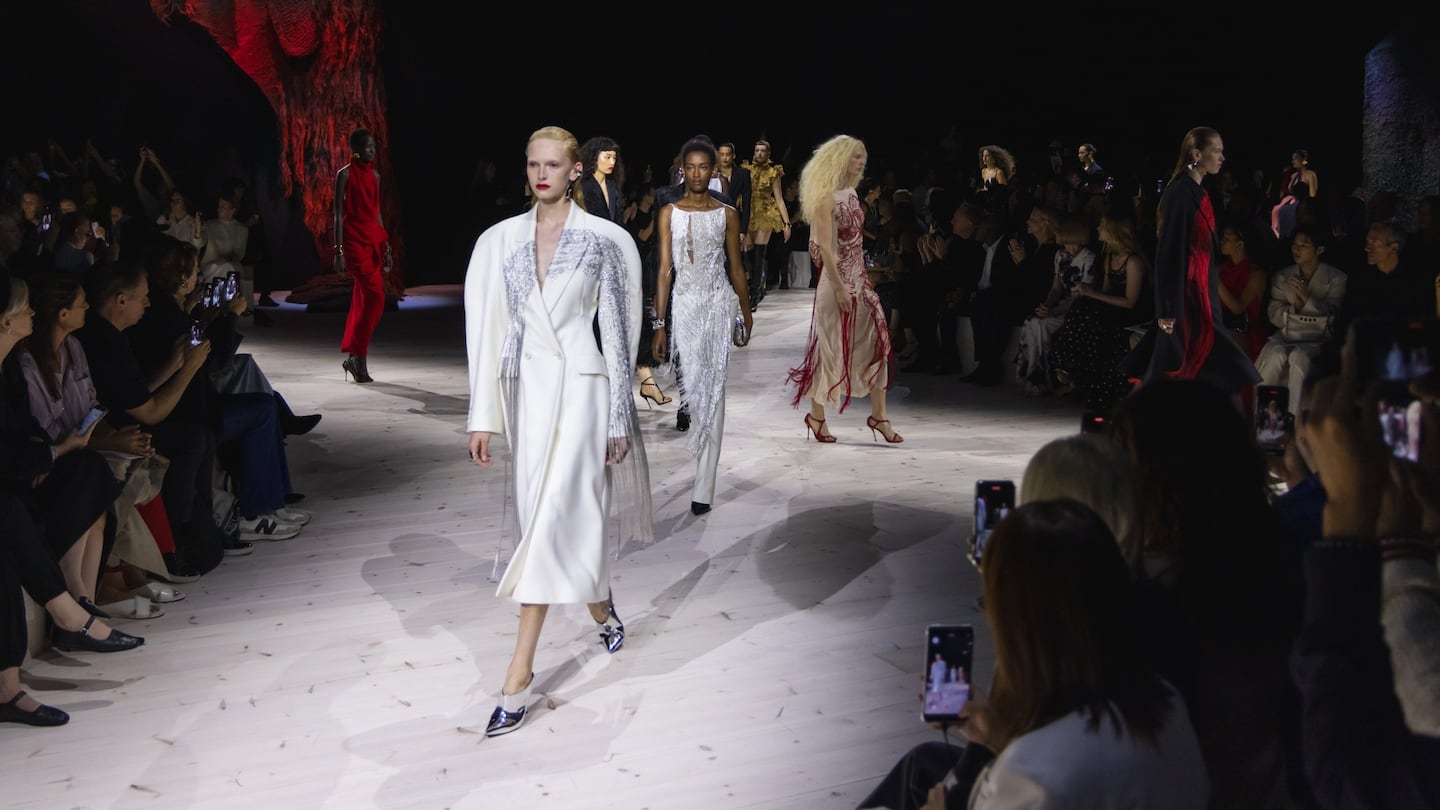
The Business of Fashion
Agenda-setting intelligence, analysis and advice for the global fashion community.

Agenda-setting intelligence, analysis and advice for the global fashion community.

PARIS — History was always fundamental to Lee McQueen’s work, so there was something appropriately medieval in the notion of the house of McQueen passing from the hands of its faithful and steady steward Sarah Burton into the nebulous unknown of the corporate quest for a successor. The sense of a long game coming to an end added an additional layer of drama to Burton’s farewell on Saturday. She dedicated her last show to Lee’s memory. And she so clearly defined her own contributions to his legacy that you felt for whoever has to follow her in this most sainted and benighted of fashion houses.
Burton grew radically in the job after Lee’s death in 2010, softening some of his hard edges, feminising his male precision, but still preserving the fiercely acute tailoring, the moulded leathers, the historical romance, like the Tudor roses printed here on slip dresses. The armour-like articulation on a denim jacket might have felt quintessentially McQueen but it was actually pure Burton. Same with her attention to surface detail, which was most macabre/gorgeous in the jacket smeared with blood red embroidery ending in a dripping trail of red fringe. (Lee’s graduate collection at Central St Martins was called “Jack the Ripper Stalks his Victims”.)
There was a pair of bumsters buried in the show, and a Pearly Queen bodysuit, and a print originally developed for 1995′s Highland Rape collection, all of them obvious tips of the cap to a McQueen past that is already distant. But Burton never lost herself in nostalgia. Lee’s family background resolved him to empower women, and that has always been an easy mandate for Burton to elaborate upon. Her own icon for her last collection was Elizabeth I. A dress of “Tudor lace” delicately layered golden oak leaves to create something you might imagine as an Elizabethan effect. But the Tudor rose was also exploded into petalled silk dresses that had a distinctly vulvic resonance. It was a typically fearless final flourish from Burton, well in keeping with the spirit of the man whose legacy she has nourished and expanded for 13 years. Beat that, her flourish said. Because if you can’t, Burton will, wherever she ends up.
0 of 47
Her tenure at McQueen pales beside Rei Kawakubo who established her label Comme des Garçons in 1969. Over the course of the subsequent five decades, she has established herself as the unimpeachable lodestone of fashion avant-garderie, and the often obtuse answer to her own questions. But maybe it’s time to change the questions, so that there is some kind of illumination in the answer. Saturday’s show elicited this statement: “To break free of the gloomy present, I hope to present a bright and light future.” Maybe not as gnomic as usual (happy to retire that word, by the way) but apply it to the actual clothes and the vision blurred.
ADVERTISEMENT
It was definitely poppy, with jolts of Barbie pink and models topped by Gary Card’s wonderful cartoon-y headpieces, but Meredith Monk’s “Slide” on the soundtrack set fillings vibrating before the usual parade of huge torso-defying shapes edged awkwardly down the catwalk. They were certainly brighter, lighter and more colourful than usual, wrapping into their impressive bulk random bits and pieces that one onlooker described as “easter eggs”: a harness, a pair of socks, shoelaces. At one point, it even seemed like the bulbous knots of fabric might be balled pantyhose. At another, there was a crumpled collage of Old Master paintings.
A high/low cultural hodgepodge would make an appropriate commentary on the current sorry state of affairs in the world at large, but as far as brighter future go, it was ambiguous at best. One optimistic note, however, was the fabulous footwear, trainers and ankle boots studded with tokens and talismans, like a lover’s diary. How telling that the most upbeat part of the collection should be, quite literally, the most grounded.
The audience went predictably wild. They always do. No one ever dares say “Empress’s Old Clothes”. Or, more to the point, “non-clothes”. But after so many years of experimentation, Kawakubo’s defiance of orthodoxy now risks looking repetitive, rather than the expression of a perpetually restless creativity. She has talked about how agonizingly painful she finds it to create, but I yearn for the days when she was committed, season after season, to thrilling reconceptualisations of real clothes that could find a place in people’s real lives. Even if the mundanity of that notion lost its appeal for her, it would be cheering to think it could now offer her some relief from all that agony: human engagement rather than endless suffering. Not wanting to sound gnomic, but it could almost be a full circle, a wonderful way to extend and protect her legacy.
0 of 19
The same kind of dilemma confronts Kawakubo’s acolyte Junya Watanabe. When you have broken so many rules, shattered so many preconceptions, where do you find the energy and the motivation to go on? “Architecture, not clothes,” was Watanabe’s answer this season. He built his looks from beams and pipes and spikes that initially looked more like Vorticist artworks than architecture (or clothes), but then the lines began to swoop and curve into startling silhouettes. The block-rocking beats of the Chemical Brothers created a concrete-solid aural backdrop for his flying buttresses of fabric.
It wasn’t one of those benchmark Watanabe shows whose combination of poetic form, pragmatic function and surreal wit makes magic of the most banal items of apparel, but he still managed to transmogrify a jean jacket or his favourite Perfecto, turning them every which way into a new architecture for the body. And I do believe I saw bags on the runway, looking like a Jiffy Pop pan with a handle. Now that’s what I mean about poetry, pragmatism and wit!
0 of 37
After 10 years as creative director, Jonathan Anderson has defined a new attitude for the Spanish brand.
The fearlessness of Rick Owens and Daniel Roseberry at Schiaparelli ought to be inspirational for the fashion industry, writes Tim Blanks.
Two of the most evocative shows of the season, one firmly based in reality, the other existing in a melancholy dream realm, writes Tim Blanks.

Tim Blanks is Editor-at-Large at The Business of Fashion. He is based in London and covers designers, fashion weeks and fashion’s creative class.
From where aspirational customers are spending to Kering’s challenges and Richemont’s fashion revival, BoF’s editor-in-chief shares key takeaways from conversations with industry insiders in London, Milan and Paris.
BoF editor-at-large Tim Blanks and Imran Amed, BoF founder and editor-in-chief, look back at the key moments of fashion month, from Seán McGirr’s debut at Alexander McQueen to Chemena Kamali’s first collection for Chloé.
Anthony Vaccarello staged a surprise show to launch a collection of gorgeously languid men’s tailoring, writes Tim Blanks.
BoF’s editors pick the best shows of the Autumn/Winter 2024 season.